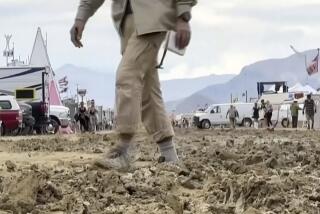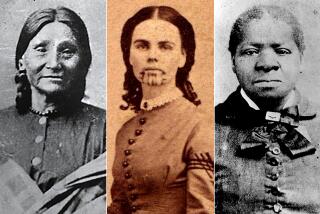Women Are Better Able Than Men to Survive Calamity, Research Finds : Anthropology: Body fat, metabolism and temperament cited in study of Donner Party death patterns.
SEATTLE — Women are twice as likely as men to survive extreme cold and hunger, based on new research on the Donner Party, 19th-Century pioneers who resorted to cannibalism to survive winter in the Sierra Nevada.
More body fat, a lower metabolic rate and a temperament that is less prone to aggression make females the hardier sex when it comes to surviving disaster, according to archeologist Donald Grayson of the University of Washington.
In analyzing death patterns among the 87 in the Donner Party, Grayson found that females who were older than 5 but younger than 50 and members of large families had the highest survival rate. Of the group’s 53 males, 30 died, while only 10 of the 34 females died.
“I found it especially interesting that so many men died so early,” Grayson said. “They just went like flies.”
The group was stranded in the mountains from October to April. Of the 25 men who died after reaching the Sierra Nevada, 14 died by the end of January, while all of the 10 females who perished died in the later months.
Results of Grayson’s study were published in the Journal of Anthropological Research.
Eighty-seven pioneers, led by George and Jacob Donner, left Springfield, Ill., by wagon train in August, 1846, bound for the Sacramento Valley. The group was delayed because they chose to travel an untested route between Wyoming and Nevada, and found themselves starting over the mountains in eastern California just as the winter snows hit.
Camped out in log cabins for the winter, the pioneers ate their draft animals, pets and a “soup” made from boiling animal hides and bones.
“We had to kill littel Cash the dog and eat him--we ate his entrails and feet and hide and and everything about him,” wrote Virginia Reed, a 12-year-old survivor.
By February, Donner Party diaries show that to stay alive pioneers were eating their dead and the practice had almost become routine.
“Mrs. Murphy said here yesterday that she thought she would commence on Milt and eat him . . . it is distressing . . . Satd. 27th beautiful morning,” wrote Patrick Breen, a 40-year-old survivor.
The demographics of the Donner Party provide a solid case of “natural selection in action,” Grayson said. Unlike most cases of famine, the pioneers’ struggled with both extreme hunger and intense cold.
Another difference: Donner Party men did not take control of resources, but shared food and shelter with their families, Grayson said.
Age, the size of one’s social group, and most of all gender, the archeologist said, were key in determining who lived and died in the 10-foot snows of the Sierra Nevada.
Women have a greater percentage of surface fat that insulates them against cold, Grayson said. Females also consume energy less quickly than men--an adaptation that aids pregnancy--thereby holding an extra store of energy.
Such assets may have helped women survive an attempt by 13 pioneers to snowshoe out of the mountains in late December. Five women and eight men made the 33-day trip. Six died--all of them men.
Basic personality differences, namely a female temperament that relies more on cooperation than aggression, also meant the difference between life and death, Grayson said. Two of the men were murdered before the group reached the mountains. One man who had no wagon or draft animal died when he was denied access to transportation. Another man was accidentally shot and killed.
University of Nevada archaeologist Don Hardesty said that Grayson’s findings were consistent with other studies. But Grayson’s research, he said, is not conclusive.
“It’s an interesting start at trying to look at the interaction of social effects and gender-based, biological variation,” Hardesty said. “But there are too many unanswered questions. Did children survive because of parental behavior? Were men more protective of women?”
Based in Reno, Hardesty conducted archeological digs at Donner Party encampment sites in 1984 and 1990. The party members, he noted, were among 350,000 immigrants to cross the California Trail from 1841 to 1866 but were the only ones to suffer a long period of extreme cold and famine.
Grayson said that he witnessed female survival traits on his own archeology excursions in the Oregon and Nevada deserts.
“When our vehicles broke down or got stuck in the desert the men were good at things calling for short-term aggression--wrestling the car out or carrying back lots of food,” Grayson said.
“But if . . . muscle-power didn’t help, the men just got angrier and angrier, whereas the women didn’t lose their tempers,” he said.
As expected, the youngest and oldest members of the Donner Party were the most likely to succumb. Of the 16 children under 5, 10 died, and of the five adults ages 49 to 69, none survived.






